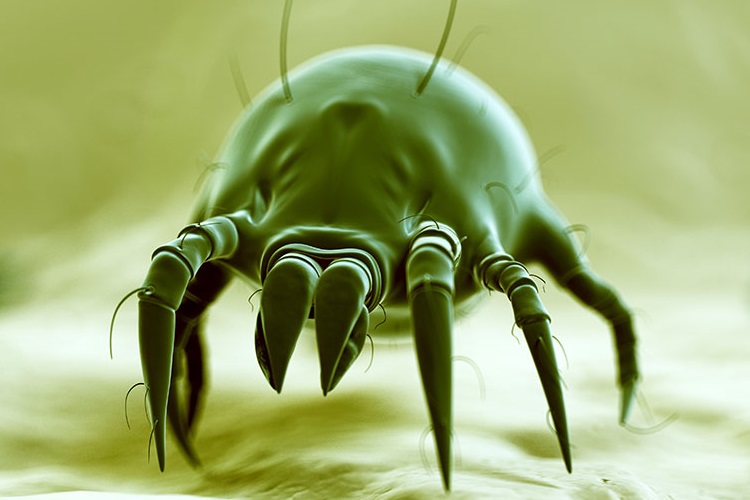Everything You Didn’t Want to Know About Dust Mites

If you’ve never considered air duct cleaning before, you’re about to! Meet the almighty dust mite.
Millions of dust mites live in your bed and pillows, eating your hair and dead skin.
They cause major allergic reactions, especially in children and the elderly. Even grosser? You aren’t allergic to the dust mites themselves, you’re allergic to their fecal matter. Good thing you sleep on a pillow full of them!
But many dust mite risk factors can be mitigated with a good air duct cleaning. If someone in your household is allergic, or if the idea of it just creeps you out- getting your ducts cleaned is essential.
What are dust mites?
Dust mites are microscopic bugs that live on dead skin cells shed by humans and pets. While they don't carry diseases, their feces can cause serious allergic reactions.
Dust mites congregate wherever there are skin cells and dander. Unfortunately, these areas tend to be where we spend the most time, so our favorite places to lounge around the house are packed to the brim with these mites.
The average human sheds 10 grams of dead skin each week, and pets create even more dander. Around 80% of the dust you see floating in a sunbeam is dead skin flakes! That certainly gives dust mites enough food to survive.
Dust mites by the numbers
Here are some not-so-fun facts about dust mites!
- Most mattresses contain 100,000 to 10 million mites.
- 100,000 dust mites can live in one square yard of carpet.
- One dust mite creates 20 waste droppings each day. Multiply that by the number of mites in your mattress!
- 10% of the weight of a used pillow may be dead dust mites and their droppings.
Where do dust mites live?
Dust mites primarily live in your bed, where you spend ⅓ of your day. Mites like warm, moist environments- namely, the inside of your mattress when you’re lying on it.
The carpets in your bedroom and your home’s upholstery also hold thriving dust mite populations.
Dust mites also live in your car, especially where you touch: your steering wheel, radio, car seats, and gear shift.
What do dust mites do?
Dust mites are medically significant because their microscopic feces and cast skins can induce huge allergic reactions.
While some dust mite allergies are passed down genetically, the allergy can also develop over time.
Up to 30% of Americans are allergic to dust mites. Meanwhile, almost half of all American homes have high enough levels of dust mites to induce new allergies.
Even worse, dust mites can cause nasal polyps.
What are the symptoms of dust mite allergies?
When you are allergic to the proteins in dust mite feces, antibodies will develop in your body when you come in contact with the feces or inhale it.
The antibodies release histamines, causing swelling and irritation of the respiratory system, as well as nasal congestion.
Here are some other symptoms to look for:
- Watery eyes and runny nose
- Sneezing
- Difficulty breathing
- Itchy skin, nose, or throat
- Postnasal drip
- Cough
- Pressure and pain in the face
- Waking up in the middle of the night
- Blue colored skin beneath the eyes
Doctors can utilize skin and blood tests to confirm dust mite allergies. Dust mite allergies can easily be mistaken for other allergies, so it’s important to get tested if you have an inkling.
What makes symptoms worse?
Some things that make symptoms worse include:
- Bad ventilation
- High humidity
- High temperatures
- Indoor pollution
- Shaking the bedsheets, causing the feces to become airborne
A proper air duct cleaning can help mitigate a lot of these extra risk factors.
Are dust mites visible?
House dust mites are too small to be seen by the naked eye. The largest they get is 300 microns in length and their bodies are translucent.
They need to be magnified x10 in order to be identified correctly!
The adult male’s covering has simple striations visible from the top and bottom. Long hairs can be seen from below.
They have no eyes or antennae. They have eight hairy legs and a mouthpart group in the front of their bodies.
How can clean air ducts help?
Dust mites thrive when air is humid and motionless.
Without sufficient air duct cleaning, your home may become overly humid and encourage the growth of more dust mites. Humidity control is vital to keep the dust mites at bay.
Additionally, dust mites and their droppings get rustled around and released into the air when you walk on your carpet, move your bedsheets, sit on the couch, and more. You want your HVAC system to be in tip-top shape to suck up the dust mites when they’re loose.
Lastly, good airflow helps people with all kinds of allergies, including dust mite allergies.
Steve’s is here for you
Now that you know all about dust mites, you’re probably ready to look up “Arvada air duct cleaning near me”!
Steve’s Air Duct Cleaning has faithfully been serving the greater Denver metro area for over four decades. Our highly trained technicians are all IIRC Certified and are up to date and the latest procedures and techniques.
We have truck-mounted vacuums and a patented advanced ram air system which combine to create the most thorough air duct cleaning your house has ever seen!
Keep dust mites at bay with our advanced air duct cleaning technology and get a good night’s rest knowing that there aren’t so many creepy crawlies on your bed anymore.
Start Breathing Easier.
Your air ducts are the lungs of your home and keeping them clean keeps you and your family healthier and your HVAC equipment working optimally.

